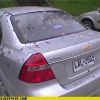This is quite lengthy, but I think any one of various parts could help someone in a similar situation:
About 6 months ago, my 2008 began issuing CEL Codes of misfires (P0300, P0301, etc). At that time the problem was fixed by a combination of replacing the coil pack, spark plugs and wires, and a full fuel rail flush.
More recently, the car began to subltly hesitate, which turned into violent lurching, bucking, etc in just a few days. The codes being thrown at various times were P0131, P0030, P0172, P0300, P1166. On a side note, do yourself a favor and pick up an Autel Maxiscan CAN OBDII Code Reader, they are only around $20. It can scan codes, resest your CEL, display your VIN, etc. Very handy.
Based on the codes, talking with others on forums, etc, the potential issues ranged from a myriad of sensors (throttle body, MAP, air intake sensor) to a clogged air filter, bad fuel filter, clogged injectors, bad catalytic converter, bad gas, bad 02 sensor(s) and/or restriction in the exhaust beyond the cat converter.
I cleaned the throttle body, 1st with cleaner, but this wasn't very affective because the butterfly valve just doesn't open very far to get the cleaner behind it, and I wasn't comfortable enough at the time to take the throttle body off entirely and clean it better that way.
I used SeaFoam in the tank and also in the Vacuum tube (the seafoam is sucked into the hose, going thru the throttle body, etc. White smoke will come from your exhaust. Have the car at 2k RPM and don't pour in too fast or the car may stall out.) to clean things out, checked the Air Filter (which was fine), checked the #1 O2 sensor (on the 2008, this was easy to get to. You have to remove 3 screws from the exhaust manifold and an open ended 7/8ths inch wrench for the sensor. Use PB Blaster or something similar on the bolts and the sensor to make the removal easier as that area gets very hot and can seize more easily. On some cars, a special 02 sensor socket is needed, which is quite expensive for just one use, but it was not required here. To make removal easier, disconnect the electric harnass so it doesn't get twisted up during removal. To disconnect requires pushing in a small tab, which I found was easiest by pressing that tab onto a nearby thin piece of metal and then pulling apart both ends.) You won't be able to tell the 02 sensor is visibly defective unless it has some major damage, mine did not.
With the car still struggling, I took it to my mechanic. A back flow test (This is done from 02 sensor hole #1, before the Cat Converter) showed excessive pressure and he thought the cat was clogged/restricted.
Thanks to a suggestion by Petrified Rabbit on this forum, I removed the 1st 02 sensor (before cat) again but left it plugged in. The idea behind this is to use the 7/8 inch O2 sensor hole as the exhaust. Since it is before the cat, if the car accelerates better or with no issues, then you can be more confident it is the cat converter or some exhaust restriction. This was quite a telling test for my car. You may want to try this out off the beaten path, because with the 02 sensor out, the car will be 'what is wrong with his car loud'. You won't want to drive it long in that state either, as the exhaust fumes are in front of you and blowing your way. Prior to this test, the car would not go over 2500 rpms in any gear, and the top speed was just under 60 mph. During the test, I could get to 4k rpms easily, as well as 70 mph easily.
Feeling confident it was the catalytic converter, my mechanic and I began the search for a replacement. The OEM part was about $1700 from the parts store and GM dealer. This was too pricey, and I believe I found the same OEM at Rock Auto for under $300. It is Catco Part #4405: CATCO Part # 4405.
During my research for a replacement part, I ran across a warranty I had never heard of called the Federal Emissions Warranty and the details can be found here: http://www.epa.gov/obd/pubs/420f09048.pdf.
Among other things, this Warranty states that "Specified major emission control components are covered for the first 8 years or 80,000 miles (whichever first occurs) on 1995 and newer vehicles."
There are 3 Major Emisson Control Components covered:
1) Catalytic converters
2) The electronic emissions control unit or computer (ECU)
3) The onboard emissions diagnostic device or computer (OBD)
I feel this Warranty is very little known, in part because most of these parts don't break down in this timeframe, and in part because it's just not well publicized. I've since talked to at least a dozen friends, etc about this Warranty, and none of them had heard of it, including my mechanic.
Since my car was a 2008 with 43k miles, I fit both criteria. This meant that the catalytic converter diagnosis, replacement part, and labor should all be covered (and they were).
I had to take the car to a certified GM technician for the work. I took mine to Alma GMC in Michigan. The service tech I talked with was Jeff, and he was very helpful. My car was fixed in just over 24 hours and runs great. I am a very happy and satisfied customer!
I was shown the old catalytic converter and the honeycomb was cracked to pieces, it was a wonder I could drive the car at all. The converter doesn't generally go bad this fast on it's own, there is an underlying cause. Keep that in mind. For my car, the prior issues could have easily contributed. Combustion in the Cat will break it down more quickly. This would be a rich fuel condition that could be caused from the Injector Issues I was having.
I hope this detailed description can help out at least one person, and maybe save someone some money as well.
Special thanks again to Jackie (Aveo Forum Customer Service), Petrified Rabbit, and Jeff from Alma GMC.
RanJmaz



 LinkBack URL
LinkBack URL About LinkBacks
About LinkBacks


 Reply With Quote
Reply With Quote My daily driver
My daily driver
 Princess
Princess Scootaloo
Scootaloo
 typeZERO
typeZERO